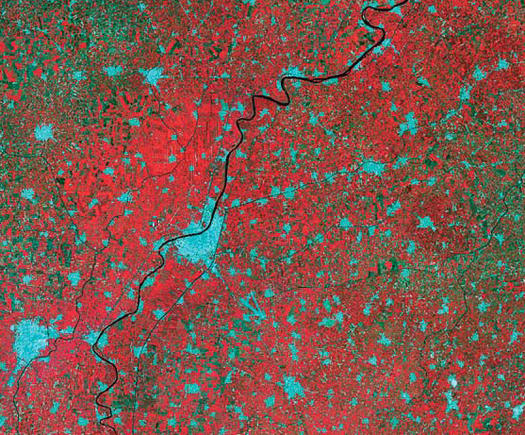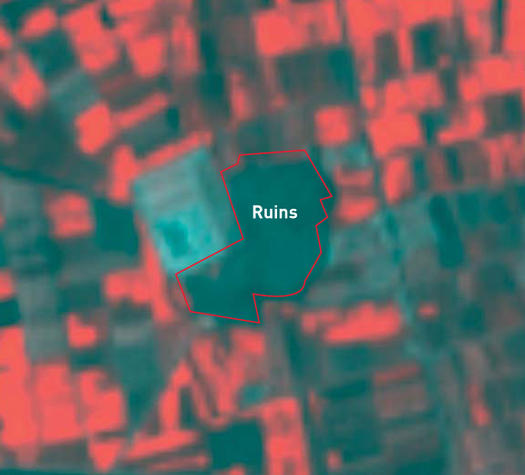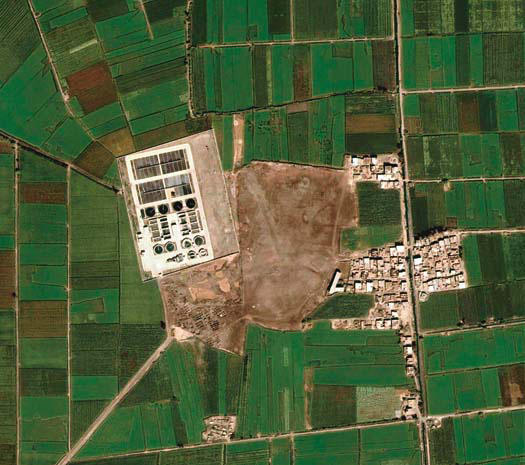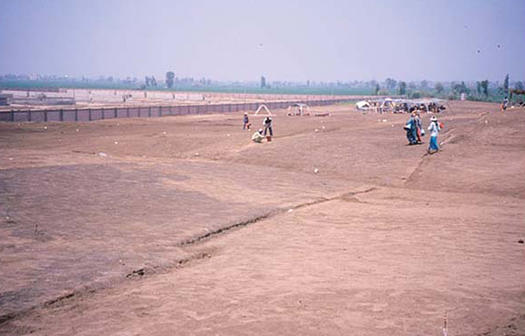Remote sensing from space
In late May, 2011, news reports began to circulate describing how images of lost, undiscovered or misunderstood archaeological sites in Egypt were being identified using remote sensing imaging data from both NASA and commercial satellites, orbiting some 700kms, (or 435 miles), above the Earth.
By directing infrared light, visible light, microwave and thermal imaging devices at the Earth and capturing resultant data with a range of high resolution cameras and other receptors, (themselves often deriving from military intelligence technology development), buried sites, not visible on the surface, come to life for archaeologists to study, governments to administer and security guards to protect.
Through trial and error in relation to satellite imaging of the Egyptian terrain, Dr. Sarah Parcak, who has done much to pioneer these techniques, discovered that the most informative images were taken during the relatively wet weeks of late winter. During this period, buried mud brick walls absorbed more moisture than usual, producing a subtle signature in contrast to the overlying sands or soils that showed up in high-resolution, infrared satellite images. This approach can detect differing densities of materials lying beneath the surface of the terrain. Those places that showed potential, higher density, building remains became "our hot spots, the places that we could end up exploring on foot," she says.
"What these satellites do is they record light radiation that's reflected off the surface of the Earth in different parts of the light spectrum," Parcak explains. "We use false color imaging to try to tease out these very subtle differences on the ground."
Those subtle differences are an archaeologist's clues to what might lie under a rice paddy or a city street. "You just pull back for hundreds of miles using the satellite imagery, and all of a sudden this invisible world become visible," Parcak says. "You're actually able to see settlements and tombs - and even things like buried pyramids - that you might not otherwise be able to see."
As of May, 2011, it seems that, in relation to Egypt alone, 17 new 'possible' pyramids, 1,000 new tombs, and 3,000 new sites in total have been identified.
This Space Archaeology satellite imaging technology could mean that we now have an enhanced potential to monitor, assess and protect archaeology from space, with high precision
Parcak received her Bachelor's degree in Egyptology and Archaeological Studies from Yale University in 2001. From 2003 to 2004,as a graduate student, Parcak used a combination of satellite imaging analysis and surface surveys in the detection of 132 new archaeological sites, some dating back to 3,000 B.C and worked on her dissertation on satellite imaging at the University of Cambridge. (Parcak said the idea to harness satellite technology came from her grandfather, a forestry professor who pioneered the use of aerial photography's application to various aspects of forestry management.) She searched scientific papers in geology and other fields for information on how to analyze satellite images; there was then no definitive textbook for remote sensing satellite imaging space archaeology.
While still in graduate school the potential of her approach soon began to become excitingly evident.
Parcak loaded an image of the Egyptian Nile River Delta taken by NASA's Landsat Earth-observing satellite into a program called Erdas Imagine, a cross between Google Earth and Photoshop that geologists and climate scientists use to analyze satellite images. All natural features-trees, water, sand-reflect and absorb light differently, and the program can tease out any unique signature the researcher is looking for. Using data from known archaeological sites, Parcak had already figured out how to sort for the high organic matter and phosphorus content that marked Egyptian "tells," or ancient house mounds. She processed the new images so that any tells would show up pink.
When she analyzed the images, her computer screen filled with pink splotches. "I thought, 'Wait a minute, those can't all be archaeological sites,' " Parcak recalls. But then she went into the field with a GPS receiver. At the pink points on the Landsat image, the delta's flat green fields gave way to silty brown mounds: remnants of tells.
(Elevated tell's typically having come into being when ancient settlements, which may or may not have been originally sited on naturally elevated ground, became elevated over time as useful materials were brought on-site and the resulting waste or worn out materials were not actually hauled away for more distant disposal.)
Parcak has since used satellite data to uncover hundreds of sites in Egypt, none of them exposed to the naked eye.
As initial techniques of such remote sensing have become refined upon it has been established that by detecting differential changes in material densities and heat stored within buried archaeological features, and comparing that with the background response of surrounding natural sediments or geology; the footprints or outline of archaeology no longer visible in the modern landscape can be seen.
For example, the hard mud brick that Egyptian houses were normally constructed from give a different signal or response, under certain types of infra-red imaging exposure, to the loose desert sand sediments surrounding it.
As of 2011 NASA's Aster satellite images the Earth in 15 different wavelengths. Sarah Parcak and others process the data using techniques that show fields as red, cities as blue and ancient ruins green.

Credit: NASA/JPL/University of Sydney
A zoomed-in view of the image reveals a subtle green mound among the red fields. The white square is a water-treatment plant.

Credit: NASA/JPL/University of Sydney
Using a visible-light image from the Quickbird satellite, Parcak spots a buried wall
[stretching from the center of the brown field toward the upper left of the brown field].

Credit: Sarah Parcak/University of Alabama
An on-the-ground dig identifies the ruins as the enclosure wall of the ancient city of Tell Tebilla, which dates from 600 B.C.

Credit: Sarah Parcak/University of Alabama
Thanks to these newly emergent satellite imaging techniques in Space Archaeology, NASA, Dr Sarah Parcak of the University of Alabama, and many others are changing the historical concept of settlement, and burial practices, in Egypt. Large areas of land can be investigated using satellite remote sensing, allowing archaeologists to get a better sense of spatial distribution, size, scale, complexity… and discover unknown sites.
The infrared images, when suitably processed, are able to be used to detect remains lying up to one foot, or thirty centimeters, beneath the earth's surface in areas where there is no modern development. Parcak suggests that there may be more sites and monuments at deeper levels still unknown.
These breakthrough findings about what satellite remote sensing imagery, and its interpretation, can reveal is a huge coup for the burgeoning science of space archaeology, but Parcak believes this is only the beginning, even hinting further finds could be buried deep below the Nile River.
"These are just the sites close to the surface," she told the BBC. "There are many thousands of additional sites that the Nile has covered with silt."
It seems that it could be possible that as little as 1% of Ancient Egypt's archaeology has been discovered! Dr. Parcak hopes to be able to continue her space satellite archaeology study to the point of completing the most thorough mapping of Ancient Egyptian archaeological remains yet achieved.
Yet Parcak's technique is not universally applicable; what works in the Egyptian delta won't necessarily work in the Brazilian rainforest. Archaeologists have to tailor remote sensing to their sites.
NASA supported a defined program of Space Archaeology related satellite remote sensing and imaging. In association with this program it recognised a number of regions across the globe as being of particular interest.

Sarah Parcak has suggested that space satellite remote sensing from space really began to be taken up by universities and businesses for civic purposes after a conference in the mid-eighties where Tom Sever, an archaeologist employed by NASA, contributed significantly to the proceedings held at the University of Alabama's Huntsville campus.
The city of Huntsville was also the location of the NASA facility where Tom Sever was based.
Sever pioneered the use of computer software to read satellite images of the Earth and identify ruins all over the world, using a technique known as remote sensing. Computers were used to process grayscale digital images from satellites; the user slides the data through a series of mathematical functions to reveal features that otherwise might remain hidden.
According to Tom Sever "The advancement is not in the sensors themselves, but in our capability to process and find information in a wide range of data."
In the 1980s, Sever used Landsat images to identify Mayan sites near a proposed hydroelectric dam project on a river along the Mexico-Guatemala border. His work was instrumental in creating the Maya Biosphere Reserve, an international conservation and sustainable development collaboration between Mexico, Guatemala, and Belize.
"When [University of New Hampshire archaeologist] Bill Saturno and I mapped all the Maya sites in this region, everybody in Maya archaeology said, 'Wow, I didn't know you could do that." But it's always been a challenge. In 1985, the head of Harvard's anthropology department told me my problem was that I was trying to bring math and science to a group of people that became archaeologists because it didn't require math.
In 2008 satellite remote sensing imaging and radar technology were used by Damian Evans and Bill Saturno from the University of Sydney to visualise the Angkor Wat complex in Cambodia from 200 miles in the air.

All forms of remote sensing, including imagery analysis in a geographic information system, geophysics, satellite remote sensing,
and aerial photography are concerned with the identification of "anthropogenic" features in such a landscape, whether they are
detecting a structure, such as a building or a town, or a system of irrigation channels and roads. In fact, "remote sensing" is a
term that refers to the remote viewing of our surrounding world, including all forms of photography, video and other forms of
visualisation. Satellite remote sensing has the added advantage of being able to see entire landscapes at different resolutions
and scales on varying satellites imagery datasets, as well as being able to record data beyond the visible part of the
electromagnetic spectrum. Remote sensors can analyze imagery … ancient remains previously invisible to the naked eye
appear with great clarity. In this way, satellite remote sensing can construct how past landscapes may have looked, and thereby
allows a better understanding of past human occupation of those landscapes.
How can people apply satellite remote sensing from space to archaeological investigations? As human beings, we can only see in the visible part of the electromagnetic spectrum. The electromagnetic spectrum extends far beyond visible parts of the spectrum to the infrared, thermal and microwave, all of which have been used by archaeologists to see through or beneath rainforests, deserts, and modern debris to locate past remains. Recent archaeologicasl findings using the electromagnetic spectrum include the discovery of many ancient Mayan sites in Guatemala (Saturno et al. 2007), ancient water management strategies at Angkor Wat (Evans et al. 2007), and details of how Easter Island statues were transported (Hunt and Lipo 2005), to name a few. Satellites record reflected radiation from the surface of the Earth in different parts of the electromagnetic spectrum, with every satellite image type recording this information slightly differently. … Ancient archaeological remains will affect the surrounding landscapes in different ways, whether through altering the surrounding soils, affecting vegetation, or absorbing moisture at a greater or lesser rate. On the ground, we cannot see these subtle landscape changes visually. Archaeologists are not necessariliy "seeing" beneath the surface with multispectral satellite imagery when using remote sensing techniques; they are actually seeing the discrepancy between higher and lower moisture content of buried walls, which affect the overlying, soils, sands and vegetation. How individuals choose to manipulate satellite data to obtain these results will vary greatly depending on landscape type, satellite image type, and the overall research goals of the archaeological project.
How can people apply satellite remote sensing from space to archaeological investigations? As human beings, we can only see in the visible part of the electromagnetic spectrum. The electromagnetic spectrum extends far beyond visible parts of the spectrum to the infrared, thermal and microwave, all of which have been used by archaeologists to see through or beneath rainforests, deserts, and modern debris to locate past remains. Recent archaeologicasl findings using the electromagnetic spectrum include the discovery of many ancient Mayan sites in Guatemala (Saturno et al. 2007), ancient water management strategies at Angkor Wat (Evans et al. 2007), and details of how Easter Island statues were transported (Hunt and Lipo 2005), to name a few. Satellites record reflected radiation from the surface of the Earth in different parts of the electromagnetic spectrum, with every satellite image type recording this information slightly differently. … Ancient archaeological remains will affect the surrounding landscapes in different ways, whether through altering the surrounding soils, affecting vegetation, or absorbing moisture at a greater or lesser rate. On the ground, we cannot see these subtle landscape changes visually. Archaeologists are not necessariliy "seeing" beneath the surface with multispectral satellite imagery when using remote sensing techniques; they are actually seeing the discrepancy between higher and lower moisture content of buried walls, which affect the overlying, soils, sands and vegetation. How individuals choose to manipulate satellite data to obtain these results will vary greatly depending on landscape type, satellite image type, and the overall research goals of the archaeological project.
Sarah Parcak, Space Archaeologist -- PART 1 from THE NEXT LIST on Vimeo.
